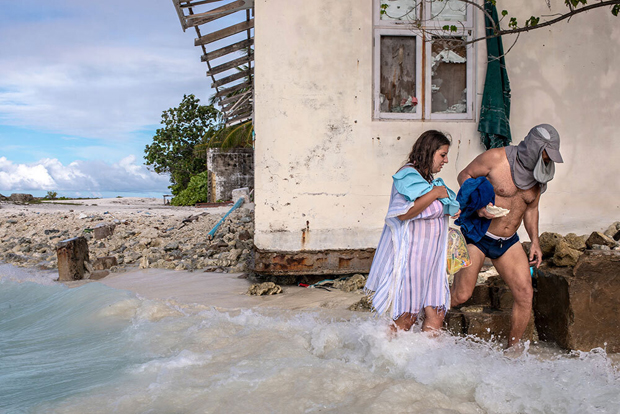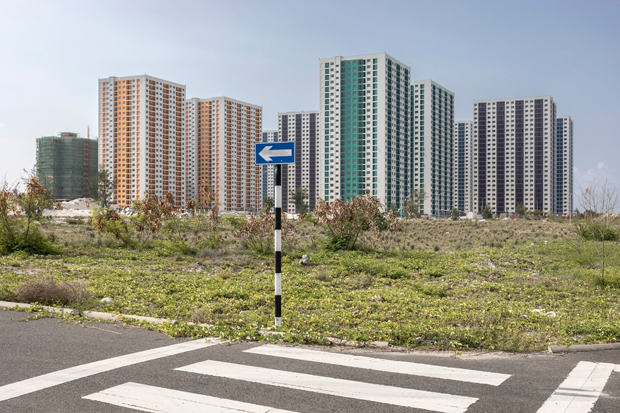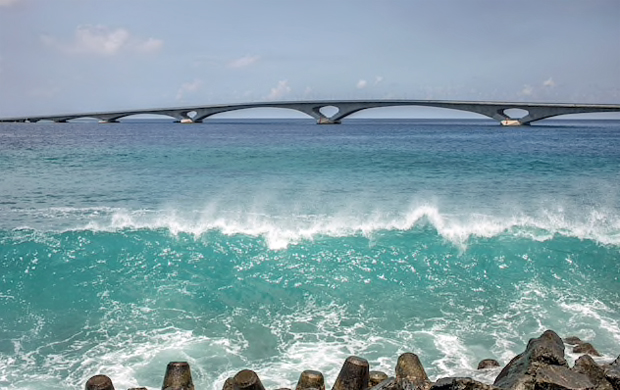
A couple navigates around an abandoned house in the Maldives, its foundations eroded by the rising sea level, to reach Bikini Beach. Photos: Marco Zorzanallo

This neighbourhood of 16 high rises, called Hulhumalé Phase II, is built on an artificial island that was created out of sand pumped from the sea floor. Residents from around the Maldives are gradually being relocated to escape the rising seas.

The Sinamalé Bridge, opened in 2018, links the islands of Malé, Hulhulé, and Hulhumalé. The nearly mile-long bridge is the first inter-island bridge in the Maldives.
27 January 22
Hulhumalé, Maldives: “My most peaceful moments are on the water,” Thoiba Saeedh, an anthropologist, said just before a motorboat took us skimming across the glassy Indian Ocean towards the tiny island of Felidhoo in the Maldives. The speedboat carved a wake between sand-fringed, palm-covered islands - some with resort villas lining wooden jetties - as a pod of dolphins butterflied through the gentle swell and flying fish launched themselves improbably into the air.
Twenty-five hundred years of maritime living have shaped the culture and identity of the people of the Maldives, a country of 1,196 low-lying islands arranged into a double chain of 26 coral atolls, so flat they scarcely breach the horizon.
Outsiders may know the islands for two things: beach holidays, and the likelihood the Maldives may become the first country on Earth to disappear beneath rising seas. That includes Felidhoo, where Saeedh wanted to show me a culture and way of life already slipping away.
Now, as the pace of climate change accelerates, this tiny nation is trying to buy time, in hopes that the world’s leaders will reduce carbon emissions before the Maldives’ inevitable demise. The archipelago has bet its future - along with a substantial sum from the national purse - on construction of an artificial, elevated island that could house a majority of the population of nearly 555,000 people. Meanwhile, a Dutch design firm plans to build 5,000 floating homes on pontoons anchored in a lagoon across the capital.
These may seem extreme measures, but these are extreme times for the Maldives. As President Ibrahim Mohamed Solih told world leaders at last fall’s United Nations climate conference in Scotland: “The difference between 1.5 degrees and 2 degrees (Celsius) is a death sentence for the Maldives.”
And that was merely the latest cry for help. A decade ago, Solih’s predecessor, Mohammed Nasheed, convened a cabinet meeting underwater in scuba gear and then proposed moving the entire population to Australia for safety.
The shift from island living in places such as Felidhoo to a man-made platform loaded with skyscrapers and named the City of Hope also carries a warning worth heeding as climate change wreaks increasing havoc on every continent: We may lose who we are even before we lose where we are. And if the Maldives manages to survive the changing planet, the question arises: What will be saved and what will be lost?
Atolls formed from prehistoric volcanoes
A million years before the dinosaurs disappeared, the Indian tectonic plate drifted north, tearing a gash in the Earth’s crust from which a ridge of volcanic peaks arose. Over time, the peaks eroded to form the coral-encrusted Maldives’ atolls.
The nation’s entire land area is just 115 square miles sitting in 35,000 square miles of ocean, with few islands bigger than 300 acres.Threaded together, the land and sea are the fabric of Maldivian identity. The relationship is one of fundamental fluidity. “When I say land, I include the water,” said Saeedh. “For us, the water isn’t separate from the land; the ‘land’ is the water and the island as a whole, because that’s where we live.” In other words, when ocean makes up more than 99 percent of your country, you’d better love it.
Most of the islands—including the capital Malé—stand about 3.5 feet above sea level; climate scientists forecast they will be inundated by the century’s end. Hulhumalé, the man-made rescue platform, has an elevation of 6.5 feet.
The development was summoned into existence in 1997 by Herculean dredging of millions of tons of sand used as fill to turn two adjacent shallow lagoons into 1,000 acres (428 hectares) of compacted sand, which is what passes in these islands as new land.
“Two-thirds of the population can be housed on these two main islands,” said Ismail Shan Rasheed, planning strategist at the Hulhumalé Development Corporation.
In many ways, Hulhumalé is an urbanist fantasy, like the start of the urban development video game, SimCity. Parks and apartments, mosques and shops, skateparks and pavements, schools and roads, have all been built in what feels like a well-ordered seaside town that was connected to Malé in 2018 by a mile-long bridge.
Rasheed himself moved to Hulhumalé in 2013, from a cramped apartment in Malé where his children had no outside space to play, and where his youngest child’s asthma was exacerbated by the exhaust fumes. He sought the public parks, green spaces, and fresh air of the planned city, Rasheed explained, gesturing at a scale model of the new development in which matchbox-sized buildings line wide boulevards. “From the point we moved onto Hulhumalé, it was okay for her,” he recalled.
But there is much more to come: phase one, already feels like a well-ordered seaside town; phase two, is still a work in progress. Last September, Aishah Moosa moved into the newest part of Hulhumalé, where a cluster of 16 24-story tower blocks is surrounded by dunes of gravel, half-built car parks and piles of trash.
Each tower is home to multiple islands’ worth of people. Moosa moved from a one-room flat in Malé, which she shared with her sister and two nephews, into a three-room apartment on the top floor of “H-2.” “There are so many people living here,” she said. “We don’t know our neighbors.”
It is better here, but not much. “We are living in these towers because we don’t have a choice,” Moosa said. “We would love to live in the islands, but there’s no education, no hospitals.” Her new home is no substitute for the communities of island living. But her tiny, marigold colored balcony offers the previously unthinkable—soaring altitude in a country with next to none. “We’re not used to this high living,” she said, glancing nervously over the balcony railing.
Ephemeral islands
The islands themselves have an ephemeral quality: sandbanks upon living coral, they grow and shrink, rise and fall, depending upon the ocean currents and sand deposits. (The list of “disappeared islands” of the Maldives is long.)
The inhabited islands, said writer, poet, documentarian, and architect Mariyam Isha Azeez, is where the Maldivian identity resides. “The Maldives is not the resorts, or this city,” she said. “It is the islands.”
Migration between islands has long been commonplace, in search of opportunity, better fishing, trade, a new home. Islands are abandoned when they become unlivable, and new ones are found. “Sailing from one island to another is a way of life for Maldivians, and has been so for many centuries,” wrote historian Naseema Mohamed, describing a seafaring lifestyle “in harmony with the ocean.”
“You must understand our relationship with the ocean. We coexist with the ocean and its creatures, its dangers and its anxieties,” she said, explaining how Maldivians are able to live with the threat of erasure. “The idea that an island will last forever is against nature.”
- AUTHOR: TRISTAN McCONNELL
- SOURCE: NATIONAL GEOGRAPHIC
Please choose your region
Australia | US / Rest of the World(Changing your region, will clear your cart)